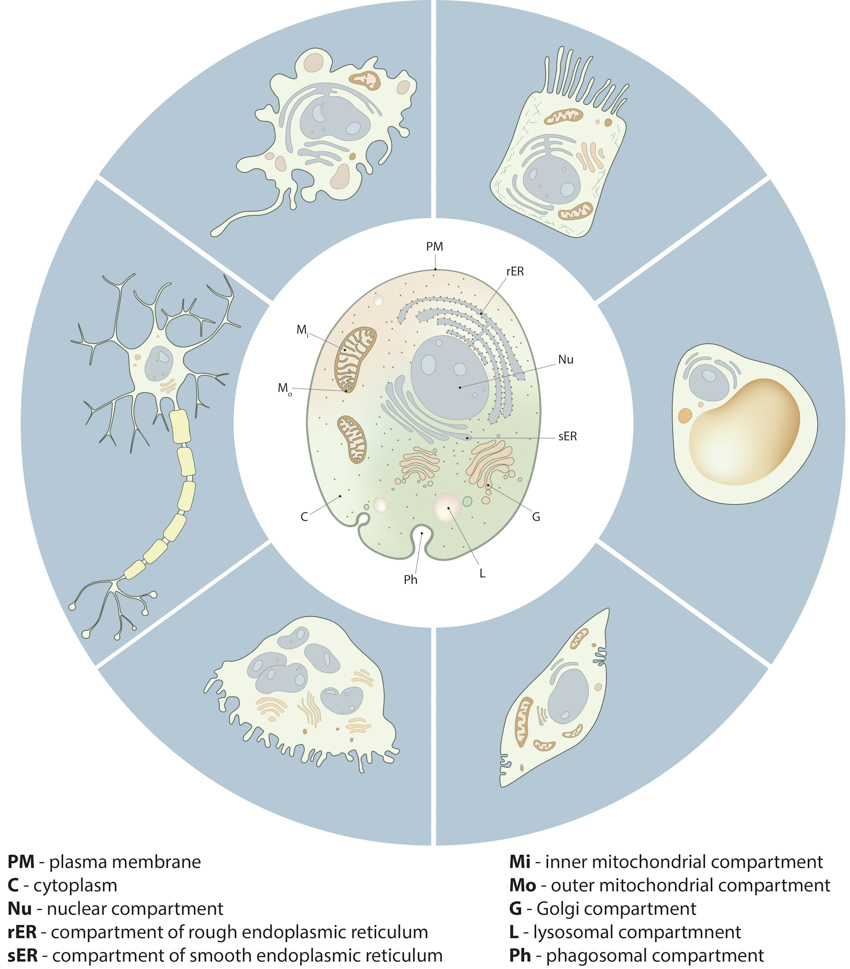In this topic
- Membrane
- Nucleus
Not only do different cell types facilitate unique functions, but their molecular, genetic and structural compositions may also differ. For this reason, different cell types often possess variations in phenotype, such as cell size and shape.
A cell’s function is achieved through the culmination of hundreds of smaller processes, many of which are dependent on each other, and share protein or molecular components. Despite the phenotypic and functional variations that exist between cell types, it remains true that a high level of similarity exists when exploring subcellular processes, the components involved, and importantly, the organization of these components.
Each of these sub-cellular regions must work coherently for the survival and efficient functioning of the cell. The adequate organization of organelles, proteins and other molecules throughout each region allows individual protein components to function in concert with each other, effectively driving individual subcellular processes that culminate in an overall cellular function.
Compartmentalization in cells
Cells are not an amorphous mixture of proteins, lipids and other molecules. Instead, all cells are comprised of well-defined compartments, each specializing in a particular function. In many cases subcellular processes may be described based on whether they occur at the plasma membrane, within the cytosol or within membrane bound organelles such as the nucleus, Golgi apparatus or even vesicular components of the membrane trafficking system like lysosomes and endosomes. Figure 1. Compartmentalization in cells:: Despite the morphological and functional variety of cells from different tissue types and different organisms, all cells share important similarities in their compartmental organization. These fundamental compartments, often referred to as organelles, are summarized in the drawing of the generic animal cell (central cell). Examples of specialized cell types, shown around the generic cell, include neuron, macrophage, intestine epithelial cell, adipocyte, muscle cell and osteoclast.
Figure 1. Compartmentalization in cells:: Despite the morphological and functional variety of cells from different tissue types and different organisms, all cells share important similarities in their compartmental organization. These fundamental compartments, often referred to as organelles, are summarized in the drawing of the generic animal cell (central cell). Examples of specialized cell types, shown around the generic cell, include neuron, macrophage, intestine epithelial cell, adipocyte, muscle cell and osteoclast.Importantly, individual organelles may be transported throughout the cell, and this essentially localizes entire subcellular processes to regions where they are required. This has been observed in neurons, which have extremely long axonal processes and require mitochondria to generate ATP at various locations along the axon. It would be inefficient to rely on the passive diffusion of ATP down the length of the axon.
Compartmentalization can also have important physiological implications. For example, polarized epithelial cells, which possess distinct apical and basolateral membranes, can, for instance produce a secretory surface for various glands. Similarly, neuronal cells develop effective networks due to the production of dendrites and axonal processes from opposite ends of the cell body. Moreover, in the case of embryonic stem cells, cell polarization can result in distinct fates of the daughter cells.
With each organelle facilitating its own function, they may be considered as subcellular compartments in their own right. However, without a regulated supply of components to the compartment, the processes and mechanisms that produce their overall function will be impeded. With many proteins and molecular components participating in multiple subcellular processes, and therefore required throughout multiple subcellular compartments, effective transport of the protein and molecular components, either by passive diffusion or directed recruitment, is essential for the overall function of the cell.
Protein Localization
In order for subcellular processes to be carried out within defined compartments or cellular regions, mechanisms must exist to ensure the required protein components are present at the sites and at an adequate concentration. The accumulation of a protein at a given site is known as protein localization.
Protein recruitment is essentially a form of protein recognition, made possible by the presence of specific amino-acid sequences within the protein structure. For example, many membrane bound proteins carry signal peptides that are recognized by signal receptors that guide them to the target site. The nuclear localization signal is one such example. Proteins that are destined for the endoplasmic reticulum also carry a signal peptide.
In other cases proteins may carry a signal patch. This usually consists of about 30 amino acids that are not present in a linear sequence, but are in close spatial proximity in the 3-dimensional space.
Interestingly, the organization of a cell, and its various regions, do play a role in directing the recruitment of proteins to a given site. For example, in epithelial cells, which are polarized, protein composition at the apical membrane is very different from that at the basolateral membrane. This is achieved through the recognition of distinct signal sequences that target proteins to each of these regions. For example, apical membrane proteins are very often anchored to GPI (glycophosphatidylinositol) while basolateral proteins have diLeu (N,N-Dimethyl Leucine) or tyrosine amino acid based signature sequences.
Directed Delivery of Components
Protein localization can result from the recognition of passively diffusing soluble proteins or protein complexes; however, this may not guarantee a sufficient concentration of components to maintain a given process. This can impede its completion, particularly when carried out in regions with a limited cytoplasmic volume, such as the tip of a filopodia, or when components are rapidly turned over.A more efficient way of maintaining the concentration of protein components is by their directed delivery via the cytoskeletal network.
The cytoskeleton, which is comprised of actin filaments and microtubules, spans the entire cell and connects the plasma membrane to the nucleus and other organelles. These filaments perform many purposes, from providing structural support to the cell, to generating the forces required for cell translocation. They may also serve as “tracks” on which motor proteins can translocate as they carry cargo from one location to another; analogous to a freight train transporting cargo along a network of railway tracks.
